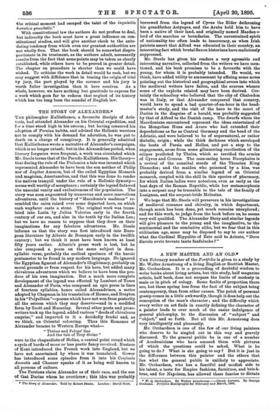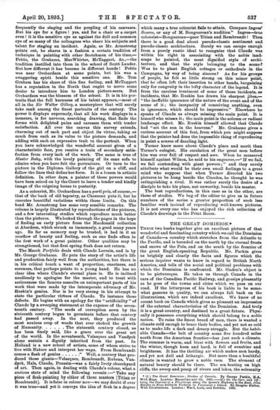A NEW MASTER AND AN OLD"
THE February number of the Portfolio is given to a study by Mr. Walter Armstrong of a living English or Scottish Master, Mr. Orchardson. It is a proceeding of doubtful wisdom to write books about living artists, but this study, half magazine article, half book, does not surpass the limits of modesty in scale or in pitch of eulogy. Some faults of proportion there are, but these spring less from the fact of the subject being contemporary, than from other causes. The patch of personal gossip comes in a little awkwardly, though it does help out the conception of the man's character ; and the difficulty which every writer on art finds in exactly defining the character of a painter leads to over much of the easier indulgence of general philosophy, to the discussion of "subject" and "object," and so forth. But all this Mr. Armstrong does very intelligently and pleasantly.
Mr. Orchardson is one of the few of our living painters who deserve to be singled out in this way and gravely discussed. To the general public he is one of a number of Academicians who have amused them with pictures of which the questions could be asked, What is he going to do ? What is she going to say ? But it is just in the difference between this painter and the others that lies what the general public is unlikely to appreciate. Mr. Orchardson, who has a fanciful and modish side to his talent, a taste for Empire fashions, furniture, and bric-i- brae, and for Napoleon, has allowed these fancies to dictate
• W. Q. Orehardaon. By Walter Armstrong.—Claude Lorrain. By George Grahame. Portfolio Monographs for February and March, 1895.
frequently the staging and the peopling of his canvases. But his eye for a figure ! yes, and for a chair or a carpet even ! it is the sensitive eye as against the dell and common eye of so many of the colleagues who share his subjects and talent for staging an incident. Again, as Mr. Armstrong points out, he shares in a fashion a certain tradition of technique in painting with other Scotchmen of his time,- Pettie, the Grahams, MacWhirter, McTaggart, 81e.,—the tradition instilled into them in the school of Scott Lander. But how different it has become in different hands ! Pettie was near Orchardson at some points, but his was a swaggering spirit beside this sensitive one. Mr. Tom. Graham has his share of this fine feeling, and McTaggart has a reputation in the North that ought to nerve some dealer to introduce him to London picture-seers. But Orchardson was the blossom of the school. It is in his por- traits that the full keenness of his talent appears,—most of all in the Sir Walter Gilbey, a masterpiece that will surely take rank among the finest portraits of the century. The power it displays supremely, that all his work displays in a measure, is for nervous, searching drawing, that finds the forms with delighted pains and caresses them with tender satisfaction. All over the canvas this survey extends, charming out of each part and object its virtue, taking as much from each as its value to the picture demands, and adding with each an expressive trait to the portrait. When you have acknowledged the wonderful account given of a characteristic face, you receive a train of secondary satis- faction from every inch of the work. The same is true of Master Baby, with the lovely painting of its cane sofa to admire when you have felt the portraiture. Or turn to the picture in the Diploma Gallery of the girl on a cliff, and follow the lines that define her form. It is a lesson in artistic definition. In other days, a painter of these powers would have been seized on by the Court to leave a tender and kindly image of the reigning house to posterity.
As a colourist, Mr. Orchardson has a partipria, of course,— that of the back of old tapestry, as Chesnean pats it, but he executes beautiful variations within those limits. On this head Mr. Armstrong has some very sensible remarks. The volume is largely illustrated by reproductions of the pictures, and a few interesting studies which reproduce much better than the pictures. We looked through the pages in the hope of finding an early picture from the Macdonald collection at Aberdeen, which struck us immensely, a good many years ago. So far as memory may be trusted, it had in it an overflow of beauty and feeling, such as one finds often in the first work of a great painter. Other qualities may be strengthened, but that first spring flash does not return.
The March Portfolio deals with Claude Lorrain, and is by 51r. George Grahame. He puts the story of the artist's life and production fairly well from the authorities, but there is in his critical touch a want of proportion, exactness, and Bareness, that perhaps points to a young hand. He has no clear idea where Claude's eternal place is. He is inclined needlessly to apologise for the master, and to treat with seriousness the famous assaults on unimportant parts of his work that were made by the intemperate advocacy of Mr. Ruskin's genius. Nor is he very strong in his attempt to state the particular virtues of Claude. To instance these defects. He begins with an apology for the " artificiality " of Claude by a sweeping statement at the expense of the seven- teenth century. " The seeds of corruption sown by the sixteenth century began to germinate before that century had passed away. In the next, they produced the most noxious crop of weeds that ever choked the growth
of Humanity The sixteenth century closed, as has been finely said, like a grave over the great art of the world. In the seventeenth, Velasquez and Vandyck alone sustain a dignity inherited from the past. In Holland is a new school of artists, some of whom strive to live with Nature and interpret her ways. From Rembrandt
comes a flash of genius " Well, a century that pro- duced those giants—Velasquez, Rembrandt, Rubens, Van- dyck, Hals, Claude, Poussin—was a fairly lively churchyard of art. Then again, in dealing with Claude's colour, what a carious state of mind the following reveals :—" Take any piece of flesh-painting by either of these masters [Titian or Rembrandt]. It is false in colour now—we may doubt if ever it was true—and yet it conveys the idea of flesh in a degree which many a true colourist fails to attain. Compare Ingres' Source, or any of M. Bonguerean's nudities." Ingres—true colourist—Bougnereau—poor Titian and Rembrandt I Then there is a good deal about pseudo-classic sentiment and pseudo-classic architecture. Surely we can escape enough from a purely rustic ideal to recognise that Claude was within his right in associating with the noble land- scape he painted, the most dignified style of archi- tecture, and that the style belonging to the scene P Was he to plant English cottages or cathedrals in the Campagna, by way of being sincere? As for his groups of people, he felt so little strong on this minor point, that he often left their insertion to other hands, bargaining only for congruity in the lofty character of the legend. It is from the careless treatment of some of those incidents, as incidents, that Mr. Ruskin has drawn his sharpest jibes,— "the ineffable ignorance of the nature of the event and of the scene of it ; the incapacity of conceiving anything, even in ignorance, which should be impressive." Elsewhere he speaks of Claude as always missing the main point. It is himself who misses it ; the main point is the solemn or radiant landscape effect. Mr. Ruskin himself allowed that Claude had " set the sun in the heavens." Mr. Grahame gives a curious account of this feat, from which you might suppose that the painter had done the impossible thing of reproducing in paint a source of dazzling light.
Turner knew more about Claude's place and merit than Turner's eulogist. His emulation of the great men before him was ever full of respect and awe. When he measured himself against Wilson, he said to his engraver,—" If we fail, we fail contending with giant powers ; " and they surely attribute what would be their own small feelings to a great mind who suppose that when Turner directed his two pictures to be hung beside the Claudes, he thought he was extinguishing a rival It was rather surely the desire of a disciple to take his place, not unworthy, beside his master.
The best reproductions, in this case as in the other, are those of studies. We beg of the editor to give us in future numbers of the series a greater proportion of such leas familiar work instead of reproducing well-known pictures. It is not every one who has enjoyed the rich collection of Claude's drawings in the Print Room.



































 Previous page
Previous page